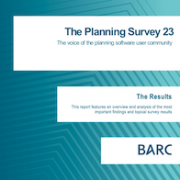Jun07

PRESS RELEASE – WÜRZBURG, June 7, 2023. The leading analyst firm BARC presents the results of The Planning Survey 23. The ninth edition of the annual study gathers the experiences and opinions of over 1,300 professionals regarding the selection and use of software for planning, budgeting and forecasting.
“The survey results underline the increasing importance of integrating planning with analytics and the growing adoption of cloud solutions. At the same time, the use of predictive planning still presents challenges. These findings provide valuable insights for companies looking to optimize their planning and forecasting processes,” commented Dr. Christian Fuchs, Senior Analyst at BARC and co-author of the study.
The Planning Survey 23 highlights three key trends that are significantly shaping the development of software for enterprise planning:
Trend 1: Integration of planning with analytics
The integration of planning with analytics is becoming increasingly important. The market for software solutions is evolving as pure planning tools are being supplanted by comprehensive CPM platforms that also support analytics and corporate consolidation. Many companies still use separate software tools for their various performance management processes, which can involve extra effort and risks. An integrated approach addresses these issues and enables the seamless connection of operational sub-plans with financial planning and corporate consolidation. Companies with merged controlling and accounting teams, as well as aligned structures and processes, benefit particularly from this integration.

Trend 2: Adoption of cloud-based planning solutions
The adoption of cloud-based planning solutions continues to progress. Today, new implementations are predominantly cloud-based. Reasons for this include increasing cost pressures, the efficient processing of large volumes of data, flexibility, scalability and a lack of IT resources within organizations. Cloud-based solutions can be quickly implemented, leading to positive time-to-value. Companies with globally distributed users are especially likely to benefit from cloud deployments as they enable web-based access from anywhere in the world and can better handle seasonal peaks in workload. The maintenance of SaaS-based solutions is handled by the provider, which is especially attractive for companies with limited IT resources.
Trend 3: Disillusionment with predictive planning
Although predictive planning software is progressing, potential buyers remain cautious. Often, the required historical data foundation is lacking in quality or completeness, which causes complications. Companies face the challenge of preparing and improving their data foundation to fully leverage the potential of this technology.

About the study
The Planning Survey 23 is the ninth edition of BARC’s annual study on the selection and use of planning software. The results are based on a global survey of 1,321 planning users, consultants, and vendors conducted from November 2022 to February 2023. The study includes a comparison of 19 leading planning solutions based on user feedback about their selection and use, as well as current data on market developments. As in previous years, BARC pledged €1 for each completed survey. This year, a donation of €1,350 is being made to WeForest, a climate change non-profit.
For more information, please visit:
About The Planning Survey 23
Aggregated product-specific results and an online product comparison tool can be found at:
Comparison of the Best Planning and Budgeting Tools of 2023
About BARC
BARC is a leading analyst firm for data & analytics and enterprise software with a reputation for unbiased and trusted advice. Our expert analysts deliver a wide range of research, events and advisory services for the data & analytics community.
Our innovative research evaluates software and vendors rigorously and highlights market trends, delivering insights that enable our customers to innovate with data, analytics and AI.
BARC’s 25 years of experience with data strategy & culture, data architecture, organization and software selection help clients transform into truly data-driven organizations.
